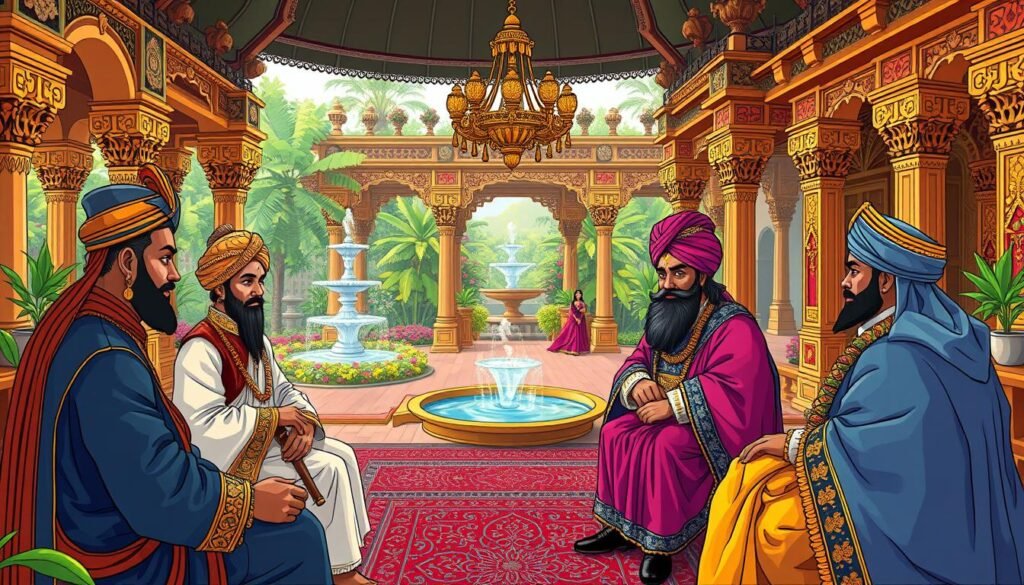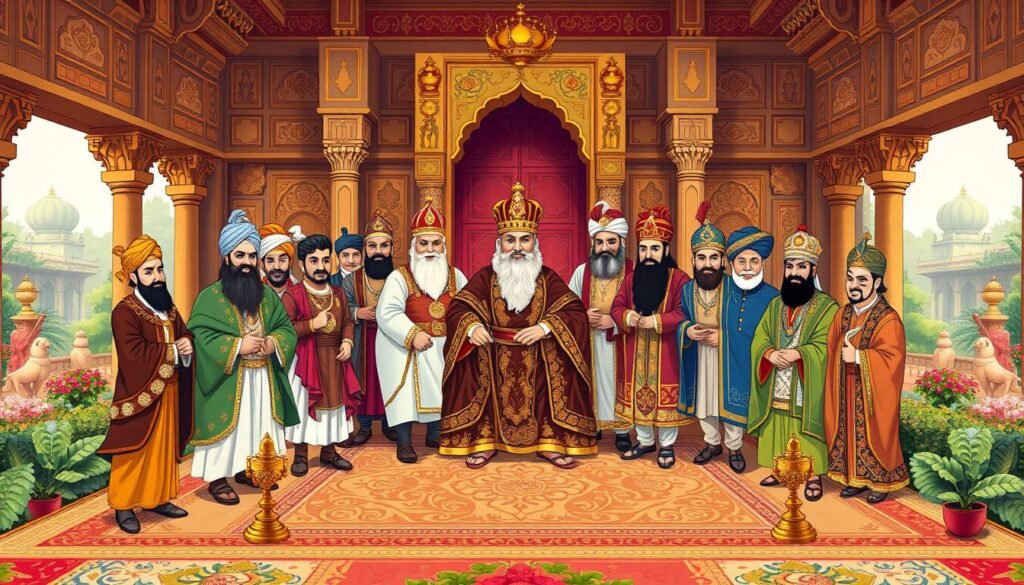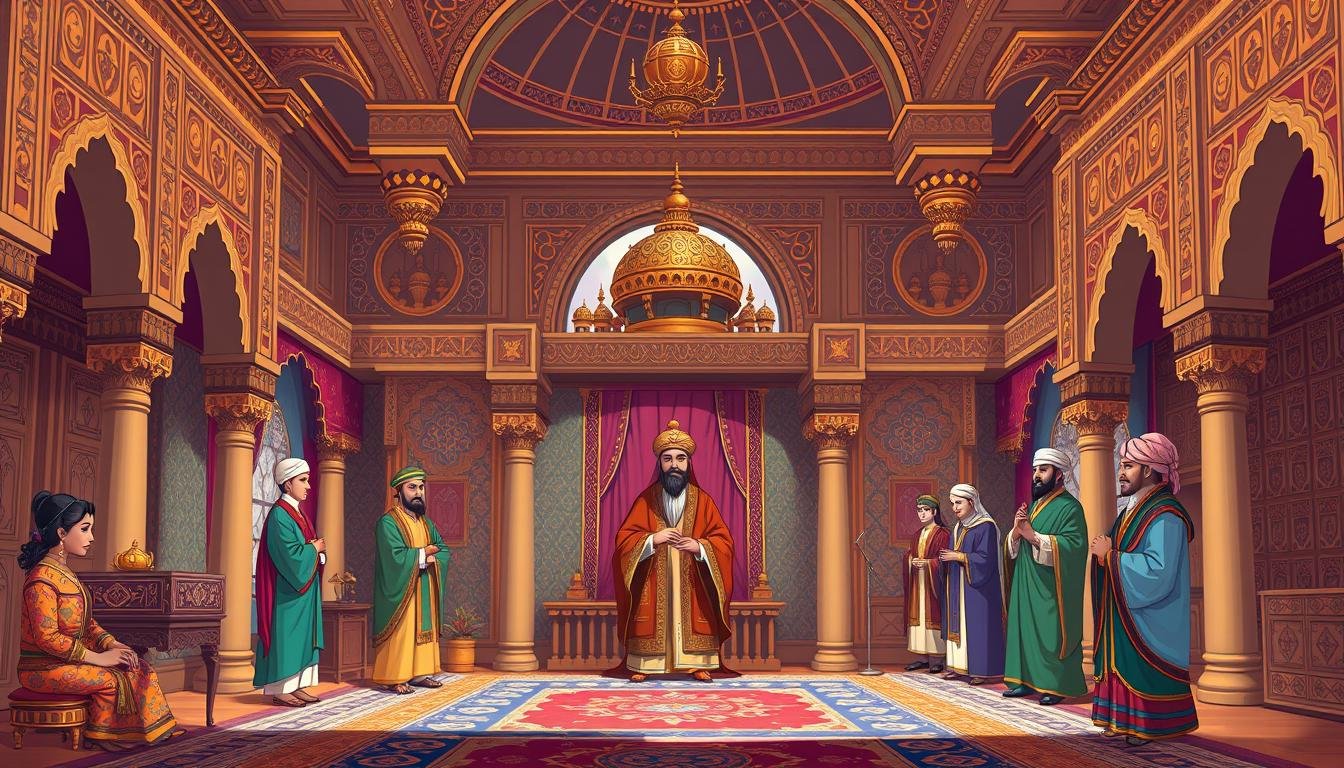Did you know the word “nabob” comes from a Muslim honorific? It’s linked to wealth and power. But it tells a story of governance and social hierarchy.
To understand “nabob,” we must look at its origins and cultural meaning. The term “nabob” comes from “nawab,” a title from the Mughal Empire. It shows the complex social structures of the time.
This journey reflects the Mughal Empire’s influence on both Eastern and Western views. Exploring this history helps us see the nabob’s definition. It also shows the differences and connections between cultures.
Understanding the Term ‘Nabob’
The term “nabob” is linked to wealth and status, especially in history. It often refers to rich people, like those from the East India Company. These individuals made a lot of money during the colonial times.
In South Asia, “nabob” originally meant Muslim rulers or important figures in states. In Britain, from the 18th to the 19th century, it meant someone who seemed very important or rich.
The nabob significance is more than just money. It shows the power these people had in politics and business. The term mixes culture and society, showing how titles could mean authority but also get laughed at.
Nabobs helped shape local governments and economies. They linked their wealth to colonial power. This shows how culture and administration mixed during that time.
For more on related terms, check out this link.
Origins of the Word ‘Nabob’
The word “Nabob” comes from the Muslim honorific “Nawab.” It shows its deep roots in India’s culture and politics. During British colonial rule, it became known for wealth and lavish lifestyles.
Originally, nabobs were people who made a lot of money. They lived in luxury, catching the eye of both India and Britain.
As the British grew their power, the story of nabobs changed. People like Bahu Begam and Nawab Shuja-ud-Daula showed the power struggles of the time. They had to deal with complex political relationships.
The term nabob became linked with luxury and governance. The Treaty of Allahabad in 1765 changed the Awadh dynasty’s power. It shows how important nabobs were in the late-Mughal era.
The word “nabob” made its way into English, showing a cultural exchange during colonization. It’s more than just about money. It touches on identity and power, still talked about today.
Muslim Honorific From Which Nabob Is Derived?
The term nabob comes from the Muslim title “nawab.” This title was for governors in the Mughal Empire. It shows a big link to South Asia’s social hierarchy.
The role of nawab was important during the Mughal Empire’s time. It showed wealth and power in society.
Exploring Historical Context
The history of nabob shows how the title changed over time. As the Mughal Empire got smaller, the title became more common. Provinces used it for their leaders.
During British rule, “nawab” was given to many leaders. This included Hindus and Sikhs. The title became a sign of power and prestige.
Cultural Implications of the Term
The term nabob still means wealth and status today. Nabobs were seen as symbols of wealth. They brought back riches from India.
People saw them as indulgent. Their lifestyle was often criticized. They were also seen as mixing Indian culture too much.

The Role of Nawab in the Mughal Empire
The title of nawab was very important in the Mughal Empire. People with this title were rich and had a lot of power. They were like governors, connecting the empire to local areas.
They had big jobs like leading armies, managing land, and making laws. This helped the empire run well.
Nawab as a Title of Nobility
The title of nawab was passed down in families. It came with special rights and duties. They had to balance the empire’s rules with local needs.
This job was both honored and hard. It needed smart thinking and hard work.
Responsibilities of a Nawab
Nawabs did more than just show off their title. They collected taxes and kept the peace. They made sure people got the services they needed.
This made them key to the empire’s success. They helped the empire work well in different places.
Connections Between Nabob and Nawab
The words nabob and nawab have a deep history. They show both similarities and differences. A nawab was like a Prince in India, ruling with Mughal Empire’s permission. They were usually men, called Viceroy. Women were called Begum or Nawab Begum.
The term nabob came up during British rule in India. It meant wealthy people who made money in India, especially with the East India Company. They used their wealth to get power in England. Even though both titles mean power and respect, they have different cultural meanings.
Nabobs were often seen as greedy in satirical books. This is different from the noble image of nawabs. Nawabs were rulers by birth in the Mughal Empire. Nabobs were a new class of rich people from colonial times. This shows how these titles were seen and used in different ways.
The Influence of Mughal Administrative Structures
Mughal governors were key in the empire’s administration. They, as nawabs, managed big areas. They kept law and order, collected taxes, and ensured stability.
The Position of Governors in Mogul India
In Mogul India, governors had a lot of power. Their family background often showed their noble status. For example, Nawab Muhammad Ali Khan’s family history highlighted their importance.
Comparison with Other Titles
Mughal titles showed a clear hierarchy. The title of nawab was special for its link to governance. Officials like Zulfiqar Khan and Mir Muhammad Amin Nishapuri showed how skills and connections mattered.

The Evolution of the Term ‘Nabob’ in Western Culture
The term “nabob” in Western culture has a rich history. It was shaped by the British Raj’s colonial influence. The word “nawab” means a princely ruler in South Asia. It evolved as British officials met these rulers.
As Europeans went to India, “nabob” became linked with a lavish lifestyle. This lifestyle showed the wealth gained from imperial ventures.
In books, “nabob” meant more than just wealth. It showed power struggles. Writers often used it to talk about the wrongdoings of colonial figures who came back to Britain.
These figures would show off their wealth. They used the title as a symbol of honor. This showed how colonial stories shaped society’s views.
Western literature often showed nabobs as greedy and corrupt. It showed the moral problems of those who made money from colonialism. This helped people understand colonial influence better.
Terms like “nabob” carried deep cultural meanings. They showed both fascination and criticism of colonial power. This shows how language and culture are connected.
The term “nabob” also changed in everyday talk. It meant not just wealth but also showing off too much. This change shows how language and culture interact. A title from Indian rulers became a symbol of colonial excess in the West.
Today, “nabob” still talks about colonial legacies. It shows the lasting effects of colonialism on our talks today.
For more on cultural meanings, look at the story of Noah. He is important in many religions. Learn more here.
Modern Usage of ‘Nabob’
The term nabob has changed a lot in today’s world. It shows how people view wealth and power. Now, it’s used in a way that pokes fun at the rich.
This term is often used to talk about unfair social differences. It points out how the wealthy are different from the rest of us.
Nabob in Contemporary Literature and Media
Books and TV shows use nabobs to show how too much wealth can be silly. These stories make us think about the rules of society and the effects of being too powerful.
By showing nabobs in a bad light, media wants us to think about fairness. It makes us wonder if everyone should have the same chance.
Related Terms and Their Significance
The term ‘nabob’ leads us to explore many related titles and honors. These go back to the Mughal Empire and beyond. Learning about these terms helps us understand the nobility titles better.
The title “nawab” means a royal position like a prince. It was given to Muslim rulers in the Indian subcontinent. This shows how the Mughal emperors shaped culture and administration.
Understanding Related Titles and Honors
There are many honorific titles, like “zamindar” for provincial governors. These titles show how they managed land and had political power. “Begum” is a title for women, showing the Mughal Empire’s complex nobility.
Cross-Referencing with Historical Figures
Famous nabobs were often seen as too flashy. But they changed British politics with their wealth from India. People like Robert Clive made a lot of money with the East India Company.
They gained a lot of power back in Britain. These figures show how nobility and governance were connected.
Conclusion
The terms nabob and nawab have deep historical and cultural meaning. They are especially important in the Mughal Empire’s history. Looking at the nabob title, we see it was about wealth and power.
But it also showed the complex ways of ruling in colonial times. Bahu Begam, for example, was a key figure. She was the main wife of Nawab Shuja-ud-Daula and had a lot of power.
She showed how these titles were linked to family and politics in early colonial India. This shows the importance of these titles beyond just names.
The influence of nabob and nawab goes beyond old times. They stand for a line of power and duty. Bahu Begam’s actions, like helping her husband and giving her wealth to him, show their importance.
Her actions show how these titles were connected to personal power and politics. Even today, their stories help us understand power and leadership.
In today’s world, nabob and nawab still make us think about legacy and influence. A full look at the nabob title shows they are more than old history. They still inspire us to think about leadership and ruling from long ago.
FAQ
What is the origin of the term ‘nabob’?
What does ‘nabob’ mean?
How has the meaning of ‘nabob’ evolved over time?
What were the responsibilities of a nawab in the Mughal Empire?
What are the cultural implications of the term ‘nabob’ today?
How do ‘nabob’ and ‘nawab’ compare?
What titles are comparable to ‘nawab’ within the Mughal Empire?
How did Western culture influence the term ‘nabob’?
What modern definitions of ‘nabob’ exist in media today?
Who are some notable historical figures associated with the title ‘nabob’?

Embracing Faith, One Insight at a Time!
The teachings of the Quran have always guided my path. With a deep passion for Islamic knowledge, I strive to blend the wisdom of tradition with the relevance of today, making the timeless messages of Islam accessible and meaningful for everyone.
Muslim Culture Hub is my platform to share historical insights and thought-provoking articles, exploring both well-known and lesser-discussed aspects of Islamic culture and beliefs. My mission is to create an inclusive online space where everyone can learn, strengthen their faith, and connect with the profound message of Islam.
Join the journey!
May peace be upon you.











